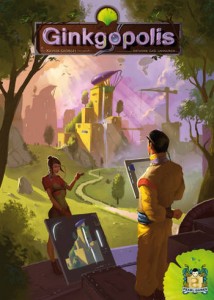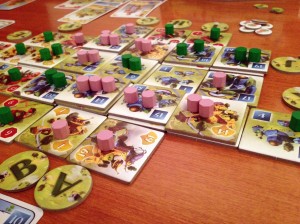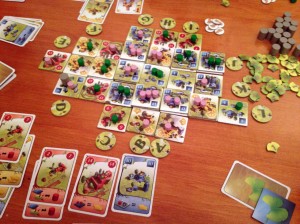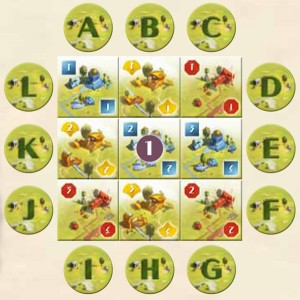Review: Ginkgopolis
Posted by James (admin) on November 13th, 2012
Ginkgopolis is by one of the designers I really like – Xavier Georges (Carson City, Royal Palace, Troyes and Tournay). Ginkgopolis is a game with the theme of futuristic, city building. As with many of Georges’ games, the game mechanic is a bit unusual (it’s actually relatively simple, although it may not seem so at first). As a result, I felt it important to explain the gameplay quite clearly (so please excuse the length of this review) because a brief outline would offer little insight.
GAME
At the start of the game, there are 9 building tiles in a 3×3 grid – 3 red, 3 yellow and 3 blue buildings with values 1, 2 and 3 – surrounded by lettered discs A-L. The initial card deck contains cards for each letter and each of the 9 starting buildings. Players start with some resources (cubes) of their own colour and some building tiles. During the game, the players will add building tiles to the 3×3 grid (on the outside as well as laying new tiles on top of existing ones). Players score victory points (VPs) when placing some tiles, and at game end for controlling areas plus bonus VPs based on cards they own. The player with the most VPs at the end of the game wins.
Actions
On their turn, players simultaneously select one card from the 4 cards in their hand and optionally place a tile face down on it too. (At the end of each round, players pass their 3 remaining cards to their neighbour who draws one new card and adds it to them to make their new hand of 4 cards.) Players then resolve their cards which are either a building card (red/yellow/blue numbered 1-20 – each matching a building tile), or an urbanisation card (lettered A-L). There are three possible actions depending upon the card played and whether a tile accompanied it:
- Gain Resources/Tiles/VPs
(a) Playing a building card on its own gains the player resources (if it’s a red card), tiles (blue card), or VPs (yellow card). The amount received is based on the height of the matching building.
(b) Playing an urbanisation card on its own gains the player 1 resource or 1 tile. - Build New Building
Playing an urbanisation card with a tile allows the player to place the new building tile where the matching letter is (moving the lettered disc outwards). The player must place one of their resources on the new tile (showing their ownership which can change during the game) and places a grey marker on the tile to show it is newly built. The player gains resources/tiles/VPs based on the tiles adjacent to the one they just placed (i.e. if next to a 2-high red building and a 3-high yellow building, they receive 2 resources and 3 VPs). - Develop Existing Building
Playing a building card with a tile allows the player to place the new building tile on top of the building tile shown on the card. A player must place resources on it equal to the number of tiles now in the stack, and places a grey marker on the tile to show it is newly built. If any opponent’s resources were on the tile, they get them back, plus an equal number VPs. If the new building tile is a different colour to the existing one, the player must pay an extra resource. If the new building tile has a lower value than the existing one, the player must pay the difference in VPs – so, it can be an expensive business. Once played, the player keeps the building card – these are ‘bonus cards’ which are very important (see below).
When the card deck runs out, the discard pile is shuffled and cards matching each newly placed building tile (the ones with grey markers) are shuffled in too. (Note: If a player doesn’t have enough resources (or a tile) required for an action, they can’t do that action.)
Bonus Cards
Actions 1 and 2 (above) give the player resources/tiles/VPs and the cards are discarded; whereas, action 3 means the player gains no resources/tiles/VPs but places the card in front of them for the rest of the game giving them one of two things:
(a) Action Bonuses
These bonuses are earned when the player performs the matching action (in addition to any normal gains). For example, the player gains an additional tile when performing action 3, or +1VP and +1 resource each time they perform action 2, etc.
(b) End of Game Bonus VPs
The cards state how the extra VPs will be earned at the end of the game. For example, +1 VP for each building of height 1 or 2 the player has resources on; or +2 VPs for each card that gives a bonus when doing action 1, etc.
Game End
The game ends when any player has placed all of their resources or the tiles have run out. Players add the VPs from their bonus cards, plus each district is scored too. A district is an area of 2 or more contiguous coloured buildings. The player with the most resources in a district scores VPs equal to the total resources in the district, and the player with the second most resources gets VPs equal to the number of their own resources.
 THOUGHTS
THOUGHTS
Overall, Ginkgopolis is a tightly, interwoven game with some interesting game mechanics. With 4 cards to choose from and 3 potential actions with each, you have quite a few options but not so many to be overwhelming and too hard to compare. If you don’t have resources or tiles, then your options are quite limited as you can only do action 1. So, maintaining some resources and tiles is very important, but sometimes it’s worth using what you have to do actions 2 or 3 too.
The decision on what to do each turn can be surprisingly deep. On the surface, you want to immediately gain resources/tiles/VPs so you look at what each gives you, but then you also think about how good the bonus actions on the cards you hold could be if you owned those. Also, is it better to have bonus VPs or action bonuses? If the latter, which actions and which bonuses will work best with your current ones and which are you likely to use most? Then, there’s the effect you can have on districts to consider – taking over an existing opponent’s tile, placing a tile to split a district, or join districts together (plus you must consider any costs of placing the tile if you don’t have the right type or value). Then, you also think about what card you don’t want the next player to have. So, there are a surprising amount of factors in your decision which makes them enjoyably tough, but with just 4 cards and limited resources/tiles, you’re usually trying to decide between just 2 or 3 options.
Balancing your bonus actions is important. If you have lots that gain you extra tiles but no resources (or vice versa) you will still have limited options. Also, do you gather multiple bonuses for the same type of action, or spread them across all the actions?
The area control game mechanic that awards VPs for control of the districts adds the extra player interaction that stops the game from feeling like a multi-player solitaire game. This simple mechanic really does make a difference as it can be worth a lot of points. However, some players may not like that the locations where they can affect districts is dependent upon their hand of cards each turn, but I didn’t mind this.
What struck me about Ginkgopolis is that it has several clever but subtle game mechanics at work under the surface. First, I thought the card passing was for players to have insight into what they may get to use on a later turn (7 Wonders-style), but this isn’t really the case as you can’t rely much on getting an unplayed card back, especially with 4 players. What it does do though is deplete the card deck slowly (1 card per player, rather than 4 per player each turn) which reduces the administration when the draw deck is empty so the game keeps flowing. In a 2-player game, it’s possible to plan using an unplayed card later, but your opponent will try to use it first if it’s obviously beneficial. Another subtle element is that keeping the bonus cards means these cards are no longer in the deck which is clever administration as they would be almost useless afterwards because the relevant tile is now buried.
As for downsides, there aren’t really any in the gameplay itself. You can end up with a hand of cards that are not very useful, but you know you can try to mitigate this by aiming to get specific bonus cards that will make actions more fruitful. The key is to play to your (bonuses’) strengths and manage your level of resources and tiles so you have options. So, luck can play a part but not enough for me to feel it’s an issue.
 One option I have yet to use is the drafting set-up. Normally, each player starts with a predefined set of 3 characters (giving different, balanced mixes of bonus actions). The advanced rule has players each choosing their 3 characters from 3 sets of cards. So, players need to decide what mix of bonus actions they want from those available, but the characters also determine each players’ starting resources/tiles too. I like the idea of this.
One option I have yet to use is the drafting set-up. Normally, each player starts with a predefined set of 3 characters (giving different, balanced mixes of bonus actions). The advanced rule has players each choosing their 3 characters from 3 sets of cards. So, players need to decide what mix of bonus actions they want from those available, but the characters also determine each players’ starting resources/tiles too. I like the idea of this.
The only issue I found with Ginkgopolis is that it’s described as a city-building game but that’s purely a theme only. Yes, you’re spreading buildings and making them taller (so city building makes clear thematic sense), but it’s not really a game of city-building deep down as placement and types of building aren’t tied in with the city aspect. It doesn’t diminish Ginkgopolis as a really good Eurogame, but just don’t expect to be planning where the airport goes, or what will happen if you put the school next to the dump.
Solo Play
Ginkgopolis can be played solo. I’m pretty demanding when it comes to single-player games as most just don’t give you interesting decisions or are too prescriptive; however, I enjoyed Ginkgopolis as a solo experience. It’s played the same way, but you get a hand of 2 cards each turn and an invisible opponent (called Hal) performs action 2 or 3 each round (with a randomly drawn tile) and gains VPs instead of tiles/resources. Hal keeps cards from action 3 as usual and gets the end of game bonus VPs from them, but not the action bonuses.
Played solo, the decisions are still interesting as you try to balance your resources/tiles/cards and manipulate control of districts. As Hal, plays a randomly drawn card and tile each turn, his effect on the districts is quite random and can weaken as much as strengthen his position. Also, Hal can’t play so his actions have synergy with his bonus VP cards. As a result, the solo game is against a random opponent (making their score quite random too); however, I still found it a good challenge and enjoyed working out how to get the best out of my turns to get the best score I could.
CONCLUSION
In the end, I really enjoyed Ginkgopolis. My first game felt like I was playing, and not just learning, the game; however, my second game was when I really started playing as I then understood my options and their impact better.
In my professional work (improving games designs and mechanics) and in this blog, I always come back to the importance of interesting decisions because these lay at the heart of any good game – and Ginkgopolis really does contain these. The city-building aspect may be thematic only, but Ginkgopolis is a really interesting and clever Eurogame which packs lots of hard decisions into a short game length. I could imagine this being nominated for the Spiel des Jahres next year – just not sure if it would be for the regular or complex prize.
James.
[Played with 1 and 2 players]



